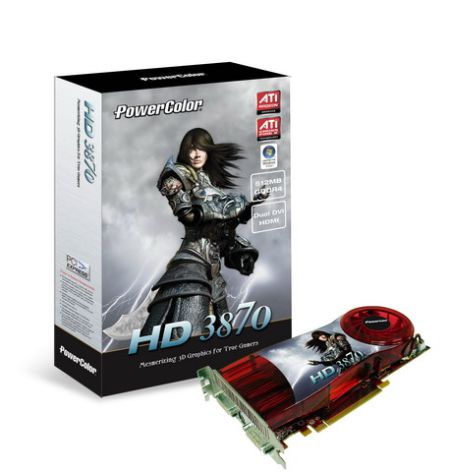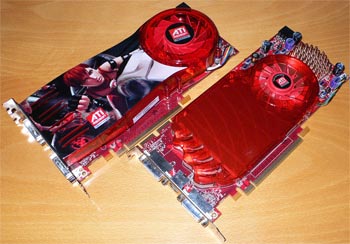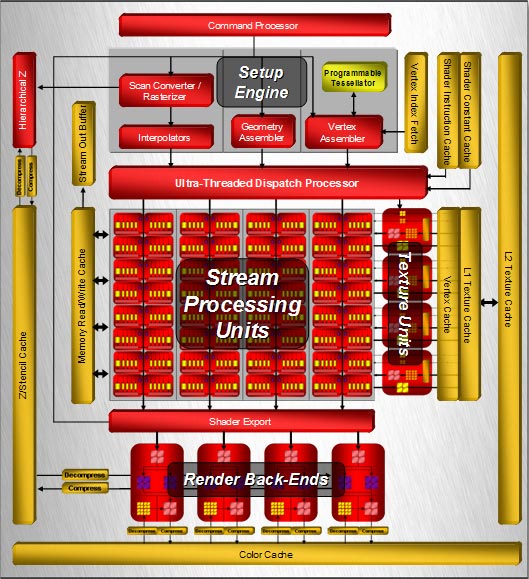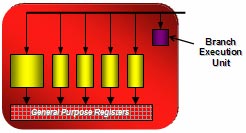Radeon HD 3870

It is hardly a secret for anyone today that the first generation of mass graphics processors with support for DirectX 10, as well as video adapters based on them, turned out to be extremely unsuccessful - first of all, in terms of performance. Despite the innovative architecture, the ATI Radeon HD 2600 and Nvidia GeForce 8600 fared poorly in games, often yielding to the solutions of the previous generation, although not so perfect, but without obvious bottlenecks in the form of a small number of execution units, as well as insufficient optimization drivers. An equally important constraint was the use by both giants of the graphics market of a 128-bit memory bus, which is clearly unable to saturate the GPU with data in modern games, especially when using FSAA and high resolutions.
It seemed that AMD, the current owner of all the assets of ATI Technologies, should hurry up with the "weapon of retaliation", especially in light of the company's increasingly precarious position in the consumer 3D graphics sector. Under AMD's leadership, ATI's revenue in the second quarter of calendar year 2006 this year fell by 40% compared to the second quarter of 2006, while ATI's Radeon market share fell to 19.1% from 27.6% at the time of the announcement of the merger between ATI and AMD. Obviously, AMD urgently needed measures to rectify the situation and get back on track. A quick announcement of the new RV670 GPU and the establishment of mass deliveries of solutions based on it could just be such measures, especially since the processor was successfully tested back in August last year, however, Advanced Micro Devices has decided to launch a new line of ATI Radeon HD as part of the announcement of a new gaming platform, codenamed "Spider". In turn, its launch has been repeatedly delayed due to problems with AMD Phenom processors reaching the required clock speeds. As a result, the announcement of the platform was delayed until November 19th, and even by this time, new AMD processors could only reach 2.30 GHz, and the graphics division continued to suffer losses. However, back to the RV670, which, albeit with a delay, but still, finally saw the light. and even by this time, new AMD processors could only reach 2.30 GHz, and the graphics division continued to suffer losses. However, back to the RV670, which, albeit with a delay, but still, finally saw the light. and even by this time, new AMD processors could only reach 2.30 GHz, and the graphics division continued to suffer losses. However, back to the RV670, which, albeit with a delay, but still, finally saw the light.
Previously, ATI Technologies has been repeatedly and rightly criticized for the confusion in the names of its products. She did not change her habits even now, being a division of Advanced Micro Devices. It was expected that video adapters based on RV670 would be called Radeon HD 2950, which would be quite logical from the point of view of common sense - the new chip could not be called revolutionary; it was a natural evolutionary development of the R600. Instead, the naming system has been completely changed, and the new family is called the Radeon HD 3800, as if it were based on a new generation of GPUs. The presence of support for DirectX 10.1 was not the basis for assigning the status of "next generation solutions" to new products, however, what's done is done, and the new AMD ATI Radeon graphics cards are marked as follows:

ATI Radeon HD 3850
ATI Radeon HD 3870
ATI Radeon HD 3800 architecture
AMD went further in mastering more subtle technical processes than Nvidia - its chip became the first GPU in the world to use 55nm production standards, which allowed it to confidently cross the 700 MHz mark, at least in the older Radeon HD 3800 model. reduce the complexity of the chip, apparently by optimizing the internal architecture of the chip and simplifying the topology of the ring memory controller, since the number of functional blocks RV670 corresponds to R600. This is the first case in a long time when a new ATI GPU lags behind a similar class Nvidia GPU in terms of the number of transistors. From this point of view, ATI managed to become a technology leader again, but what do the new products look like in comparison with the GeForce 8800 GT?
First of all, the ATI Radeon HD 3800 outperforms the Nvidia GeForce 8800 GT in the core clock, which, however, is compensated by a smaller number of functional units, such as TMU. A significant advantage in the number of execution units, as we already know, is not essentially such, and it's not only and not so much that the ALUs in Nvidia chips operate at a higher frequency: the VLIW architecture implemented in Radeon HD requires especially careful driver optimizations to ensure efficient shader code parallelization. Otherwise, if it is not possible to load all ALUs with independent instructions, the performance of Radeon HD superscalar shader processors drops sharply; in the worst case, only 1 ALU out of every 5 that are part of each of the 64 such processors can be used. Ironically, it is AMD/ATI Technologies that has the most problems with software optimization, as it does not have access to the code of games developed under Nvidia's "The Way It's Meant To Be Played" program before their official release. Often, this state of affairs directly affects the performance of AMD/ATI graphics solutions in games, and, of course, not for the better.

If you focus solely on the block diagram of the RV670, then it will not be possible to detect differences from the R600 on it. They lie at a deeper level, so they should be discussed in more detail. Notable differences between RV670 and R600 include support for DirectX 10.1 (Shader Model 4.1) and the presence of a full-fledged hardware UVD video processor, similar to the one included in the ATI Radeon HD 2600.
Like the R600, each RV670 shader processor consists of six blocks - five ALUs and one block for executing flow control instructions such as branches, match checking, loops, and subroutine calls. In addition, it contains a set of general purpose registers

Of the five ALUs, four are simple, capable of executing one FP MAD instruction per clock, and the fifth ALU can also execute complex instructions such as SIN, COS, LOG, EXP, etc. This architecture is extremely flexible and highly scalable, but its weak point is its dependence on software optimizations. Although ATI Radeon HD graphics cores include a special task manager, its efficiency directly depends on the efficiency of the shader code compiler, which is part of the drivers. The fact is that the superscalar architecture achieves the greatest efficiency when all ALUs are busy performing independent operations, and this is quite difficult to achieve, since in 3D applications many operations depend on the results of the previous ones.
Architectural texture and raster processors of ATI Radeon HD 3800 also do not differ from similar blocks of ATI Radeon HD 2900. They are complex devices, so we can only speak about their equivalence to traditional TMUs and ROPs. In total, the RV670 has four large texture processors, each of which contains the following blocks inside:
8 texture address units
20 texture fetch units
4 texture filter units

Each of the RV670 raster processors contains:
4 alpha and fog units
8 Z and stencil buffer units
4 blending units
16 multisampling processing units
Thus, it is approximately equivalent to 4 classic ROPs and can process four pixels per clock, a total of 16, since there are four such processors in total. In the case of working with a Z-buffer, i.e., pixels that do not contain color data, the performance is doubled and is 32 pixels per clock. Like the texture units, the RV670's raster processors have undergone some pretty major changes to support DirectX 10.1 features.
The RV670 memory controller has been improved and the memory bandwidth is used by the new chip much more efficiently, which allows it to compete on equal terms with the R600. However, in practice, we can only see a decrease in the width of the external memory bus from 512 to 256 bits, as well as a decrease in the total width of the controller's internal ring buses from 1024 to 512 bits. More subtle changes, if any, are unfortunately hidden from us, and we cannot say whether the declared comparable performance of the RV670 and R600 is their result, or the result of inefficient use of the memory subsystem capabilities of the latter. We are inclined to the second option, since in real gaming conditions the presence of a 512-bit external memory bus with a bandwidth of over 100 GB / s.,
The ATI RV670 is also the world's first desktop GPU to offer the same advanced power management capabilities as ATI's mobile graphics cores. Thanks to ATI PowerPlay technology, the new chip is able to flexibly control its frequencies, supply voltage, and even turn off unused blocks when the core is lightly loaded. Unlike other desktop GPUs, RV670's power-saving features are built into the hardware to provide faster load response and eliminate GPU detection errors.
In the history of ATI Technologies, there have already been cases when the company supported a standard that had not received wide distribution before. For example, the ATI Radeon 8500 supported the Pixel Shader 1.4 specification, which was part of DirectX 8.1. These specifications were much more flexible than the PS1.0/1.1/1.3 supported by Nvidia chips and allowed for higher quality special effects, but it was precisely because of limited support that they were not widely adopted by game developers during the life cycle of the ATI Radeon 8000. A similar fate befell Shader Model 2.0b support implemented in the ATI Radeon X700/X800/X850 family, as well as Shader Model 2.0a promoted by Nvidia in the GeForce FX family. DirectX 9 Shader Model 3.
DirectX 10.1 was the first and last subset of DirectX 10. It was officially included in Windows Vista with the release of Service Pack 1
Key innovations in DirectX 10.1:
Support for arrays of cubemaps: allows you to achieve acceptable speed when using global illumination of the scene by accessing several cubemaps in 1 render pass. This global illumination method includes the calculation of indirect diffuse illumination, refractions, soft shadows, and more accurate calculation of reflections.
Improved deferred rendering and FSAA techniques: support for independent blending modes for each MRT, mandatory support for MSAA 4x, support for writing pixel coverage masks from the shader, pattern sample selection, sampling from the multisampling buffer, support for pixel detection filters that require anti-aliasing.
Increased the number of vertex shader registers: the new specifications provide 32 registers instead of 16 in the DirectX 10 specifications.
Gather4 Support: Similar to the Fetch4 feature in the ATI Radeon X1000, allows fetching a block of 4 pixels (2x2) for a single-component texture. Serves to speed up work with shadow maps and improve the quality of shadows.
Improved blending and filtering techniques: support for the LOD instruction that returns the level of detail for a filtered texture fetch, support for INT16 for blending and FP32 for filtering (INT8 and FP16 in DirectX 10)
The RV670 GPU impresses with its core size - despite the fact that it consists of 666 million transistors, its area is only 192 square millimeters (13.7x14 mm.). This clearly shows what the new 55nm process is capable of. Except for the ATI logo and the date of manufacture, the core does not carry meaningful information for the end user. Our copy was made on the 39th week of 2007, which fell on September 23-29. Since ATI Radeon HD graphics processors do not declare different clock frequencies for different parts of the chip, despite the fact that different domains operate at 26 different frequencies, it is customary to indicate only the "main" frequency of the chip; for the Radeon HD 3870 it is 775 MHz. The packaging of the crystal is devoid of a protective frame, therefore,
In terms of block configuration, there are no differences from ATI Radeon HD 2900 XT: the chip contains 320 ALUs grouped into 64 superscalar computing units with 5 ALUs each. At the same time, 4 ALUs in each such block are capable of executing simple instructions such as MAD (Multiply+Add), and the fifth, more complex, can also execute transcendental instructions such as SIN, COS, LOG, EXP, etc. Additionally, each computing processor contains a branch control block responsible for executing flow control instructions (comparisons, loops, subroutine calls, etc.). The only difference from the R600 in this case is support for advanced DirectX 10.1 features (Shader Model 4.1)
Specifications ATI Radeon HD 3870
| Name | Radeon HD 3870 |
| Core | RV670 |
| Process technology (µm) | 0.055 |
| Transistors (million) | 666 |
| Core frequency | 775 |
| Memory frequency (DDR) | 1125 (2250) |
| Bus and memory type | GDDR4 256 Bit |
| Bandwidth (Gb/s) | 72 |
| Unified shader blocks | 320 |
| Frequency of unified shader units | 775 |
| TMU per conveyor | 16 (total) |
| ROP | 16 |
| textures per clock | 16 |
| textures per pass | 16 |
| Shader Model | 4.1 |
| Fill Rate (Mpix/s) | 12400 |
| Fill Rate (Mtex/s) | 12400 |
| DirectX | 10.1 |
| Anti-Aliasing (Max) | MS-24x |
| Anisotropic Filtering (Max) | 16x |
| Memory | 512 |
| Interface | PCI-E 2.0 |
| RAMDAC | 2x400 |
Although the graphics cards ATI Radeon HD 3870 and ATI Radeon HD 3850 have good performance, the positioning of the HD 3870 left a very unpleasant aftertaste. As it turned out, instead of competing with GeForce 8800 GT 512MB and Radeon HD 3870, we got AMD's unwillingness to compete with Nvidia. ATI still competed not in terms of speed, but in terms of price.
Need for Speed Pro Street




